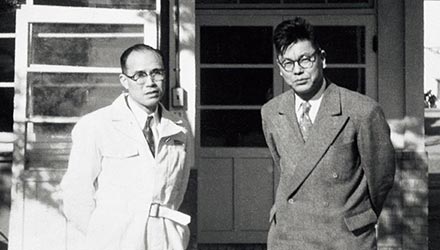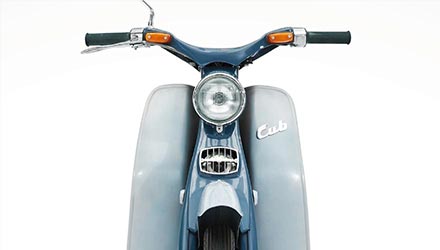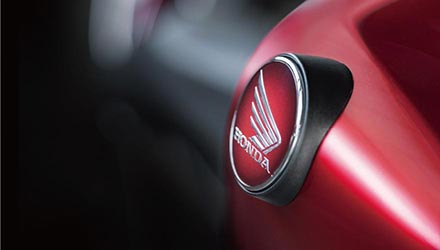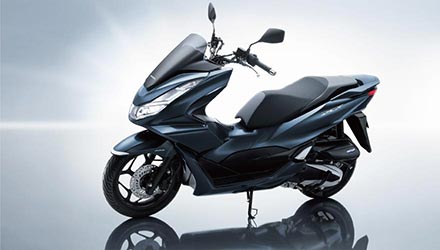Founded After World War II
to Create Mobility Products that Help People
After the second world war ended, Mr. Soichiro Honda came up with the idea of using radio generator engines from the former Imperial Army as auxiliary engine for bicycles, and established Honda Technical Research Institute, which began producing and selling these auxiliary engines for bicycles. It was only a matter of time before the inventory of engines the Army had disposed of ran out, so Mr. Honda began developing his own engines. After a series of prototypes, the company completed its first original engine, the A-type, which led to the founding of Honda Motor Company in 1948. Honda was established as a manufacturer of engine-powered vehicles at a time when road conditions were poor and ordinary people had to rely on human power for transportation. Honda was founded based on a strong desire to help people in need.
In 1949, Honda developed a motorcycle made entirely in-house, including the body frame. It was the Dream D-Type, known simply as the “Dream”. It was a significant motorcycle model that marked the beginning of the Honda journey toward realizing Mr. Honda’s dream of becoming the world's leading motorcycle manufacturer. The subsequent success of the 1951 Dream E -Type powered by a four-stroke engine put the company on a growth trajectory and solidified its foothold as a manufacturer of complete motorcycles.
The Birth of the Super Cub C100
In 1952, Honda launched the Cub F-Type auxiliary engine for bicycles. Honda quickly established its own sales network by sending direct mailings to bicycle dealers nationwide, inviting them to sell directly to customers.
Honda imported expensive machine tools and established a system to produce high-performance products with a level of precision seen only in advanced countries at the time, and created a completely new type of motorcycle: the Super Cub C100, introduced in 1958. Lightweight, compact and powerful, the C100 was proposed to the world as a motorcycle that would enrich all aspects of people’s daily lives, from commercial use to commuting to work or school, and recreational activities. The monthly sales target was set at 30,000 units, an extraordinary figure at the time, and a great deal of effort was put into advertising. In addition, to expand sales channels, Honda reached out not only to bicycle and motorcycle dealers, but also to other industries with close ties to local communities, building a unique nationwide sales network.
The Super Cub was widely used for commercial purposes and, in 1965, was adopted by the Ministry of Posts and Telecommunications for mail delivery service throughout Japan. The Super Cub was used also for the delivery of milk, a variety of meals such as buckwheat noodles, newspapers, and other everyday items, as well as for a variety of personal activities. It had created new value as transportation infrastructure throughout Japan.

Cub F-Type spread throughout Japan thanks to an extensive sales network

Super Cub C100
Capturing the Hearts of Young People
with the Coveted “Nanahan” and Leisure Bikes
Starting with its entry in the Isle of Man TT Races in 1959, Honda boldly took up the challenge of world motorcycle racing, and in 1966, became the first manufacturer to win all five classes of the Road Racing World Championship (World GP), and proved its advanced technological capabilities both inside and outside Japan.
The high output, multi-cylinder engine technology created and amassed through the development of racing machines was applied to production motorcycles, and in 1969, the Dream CB750FOUR was launched. Nicknamed “Nanahan” (Seven-and-a-half), it became the object of admiration among young people and established the reputation of Honda as a manufacturer of large, high-performance sport bikes.
On the other hand, while Honda had an established reputation for small practical motorcycles such as the Super Cub and Benly, it developed the CB, CL, and SL series of small and mid-sized sport bikes in colorful candy colors from the late 1960s through the 1970s to fill the gap with full-fledged sport bikes. In a complete change from the stoic and rugged image of motorcycles that had dominated the market, Honda made great strides by gaining acceptance by young buyers as a fashion statement.
At the same time, for the purpose of familiarizing Japanese people with engine-powered vehicles from a young age, Honda was operating amusement parks such as Tama Tech, where children could control the vehicle and enjoy the rides themselves. This amusement park equipment led to the birth of the Monkey, the starting point of Honda recreational bikes. The Monkey and Dax created a new genre of recreational bikes that are ideal for people’s daily lives, differentiated from bikes for business, commuting, or touring.

Dream CB750FOUR

Monkey Z50M
Promoting Motorsports and Safe Riding
In the 1970s, as motorization progressed rapidly in Japan, one of the negative effects was a sharp increase in traffic accidents, giving rise to the term “traffic wars.” In addition, groups of young people who ride their customized motorcycles in a rebellious and reckless manner became a societal issue, leading to association of motorcycles with bad behavior. As a result, high schools across Japan discouraged their students from obtaining a rider’s license, purchasing motorcycles, and riding motorcycles (the “Three No’s” campaign). To deter traffic accidents, the Japanese government enacted several traffic laws. In 1975, however, separate motorcycle licenses were introduced according to engine displacement, and helmet use became mandatory on all roads, which had previously been limited to expressways.
Honda, which had grown its business significantly by winning the support of young buyers for its high-performance motorcycles, tackled this issue with the belief that the healthy development of a motorcycle culture and the spread of safe riding knowledge and techniques were the key to preventing traffic accidents, and established the Traffic Safety Promotion Operations in 1970. To further promote safer and more enjoyable motorcycle riding, Honda established the Motor Recreation Promotion Center in 1973, with the aim of promoting fun and healthy ways to ride and enhancing user services. These initiatives were the result of the willingness of Honda to assume responsibility as a top motorcycle manufacturer.
In the same year, Japan’s first trial model, the Bials TL125, was launched. In an effort to popularize motorsports, Honda opened more than twenty Bials Parks throughout Japan where trial competitions could be held, focusing on riding technique rather than speed. Safety parks were also built throughout Japan as venues to enjoy motocrossing. Honda took steps to broaden the base of a healthy motorcycle culture, disassociated from reckless riding.
In 1975, Honda initiated the Safety Sports Shop (SSS) system at its motorcycle dealerships. SSS dealers provided a service to select a suitable model for a customer by establishing criteria to assess their riding experience and skill. Safe riding seminars were held in various regions and worked to protect customers through promoting safe riding at dealerships. In addition, there were many clubs throughout Japan formed mainly by dealerships, which gathered once a year at the Suzuka Circuit to mingle and provide a venue for reaffirming the importance of safe riding.
In addition, Honda began offering Honda Motorcyclist School (HMS) courses in 1978, aimed at users of medium and large motorcycles to learn safety techniques and manners, that were held at traffic education centers in Suzuka, Okegawa, and Fukuoka. The one-day school was later expanded nationwide, and was held by dealers and Honda sales offices, including distributors, for people planning to ride scooters and family bikes.

Honda Motorcyclist School held as part of Honda safe riding promotion activities
Scooter Boom Based on New Needs
In 1976, the Road Pal series, a revolutionary second-generation commuter model, was created to replace the Super Cub. Based on a concept thoroughly designed for ease of use by female users, the Road Pal was developed as a “bicycle-inspired bike” that was easy to operate and lightweight. The Road Pal was such an explosive hit that the name “Rattatta,” hummed by actress Sophia Loren in commercials, became synonymous with the model, creating a new genre of family bike.
The market response was so strong that other companies entered the new market. Demand for family bikes expanded to include students and housewives, as well as second bikes for motorcycle riders. The motorcycle market had been adversely affected by the Three NOs movement and was once again booming, leading to the scooter boom of the 1980s.
Yamaha Motor Co., Ltd. (Yamaha) saw this market expansion as an opportunity to seize control of the domestic market and launched a series of new products. Honda and Yamaha were soon locked in a fierce battle for market share.

Road Pal
The HY War: Reflections and Lessons Learned
from Extreme Battle for Market Share
In 1977, Yamaha launched the Passol model featuring a flat step, as a competitor to the Road Pal. It became a hit, outpacing sales of the Road Pal.
In 1979, Yamaha announced its intention to become the industry leader. The war for market share, the so-called “HY War”, had begun.
From 1980 to 1981, Yamaha’s share of the family motorcycle market was close to that of Honda. Honda, as the top manufacturer that had led the domestic motorcycle market up until then, hit back in order to maintain its prestige.
In September 1980, in order to develop new demand and maintain its market share, Honda launched “The Scooter,” the Tact, which was more fashionable and matched people’s lifestyles. It was an explosive hit, especially among women, and sold 110,000 units in just three months after its launch, keeping Honda at the top of the market.
Honda built upon its success, introducing new models at an astonishing pace, including the Tact Fullmark and Tact Full Back in 1981, and the Lead and Sky in 1982. As a result of the market share war, in which neither company was willing to give an inch, both companies accumulated large inventories by the fall of 1982. Yamaha, which had been outsold, announced its withdrawal from the battle in January 1983, ending the HY War.
The sales frontline was exhausted, and Honda suffered a painful blow. The competition became so heated that Honda lost sight of the most important of “The Three Joys” – the “Joy of Buying” – and competed for market share. As a result, Honda lost the “Joy of Selling” and the “Joy of Creating” as well, and this experience became an important lesson for Honda in its subsequent corporate activities.

Tact

Tact Fullmark

Lead 50 Super Deluxe

Sky
Together with Japanese Customers:
Owners Meetings

Together with Japanese Customers:
Owners Meetings
From 2014 to 2019, Honda Motorcycle Japan Co., Ltd. (HMJ) has hosted 17 CB owners’ meetings, themed “Always the one: Honda CB.” In total, approximately 11,500 customers participated, with an 84% satisfaction rate, making it an event that fostered bonds among owners through their CBs. Other events such as a “Honda Off-Road Meeting,” “Smart Riding School for Nice Middle [Aged] Riders,” and “Rebel & GB Meeting” were also held at various locations. By proactively providing opportunities to enjoy motorcycles, Honda has been striving to increase customer loyalty.
HondaGO: Providing Young Riders with Expanding
New Experiences through Motorcycles

HondaGO is a project started in June 2019 aiming to revitalize the motorcycle market. Among the programs are motorcycle ride experiences utilizing stores and facilities, as well as information shared through social media and smartphone applications.
- HondaGO RIDE: A smartphone app to support motorcycle life for all riders. HondaGO RIDE provides maintenance notes, fuel consumption calculations based on fueling records, touring plan creation and recording, motorcycle rental reservations, and new product and event announcements from Honda.
- HondaGO BIKE RENTAL: A web-based service, aiming to be easier and more accessible, HondaGO BIKE RENTAL offers bike rentals, helmet and rider jacket rentals, insurance and compensation plans, and other services to lower the hurdles of preparation and costs to ride a motorcycle, and for more people to experience the appeal of motorcycles.
- Online presence: As of 2023, approximately 70,000 members follow Honda’s online services including HondaGO RIDE, HondaGO Music Video, HondaGO Instagram, HondaGO BIKE GEAR, and HondaGO Bike Lab.
The “Joy of Buying” and the “Joy of Riding”
at Wing Dealerships
In the past Honda had nurtured bicycle dealers into motorcycle dealers, quickly building a foundation for its automobile business through its motorcycle dealers selling Honda cars as well. As Honda automobile business took off, many of these dealerships stopped selling motorcycles, necessitating a review of Honda’s dealership structure for motorcycles.
In 1979, Honda introduced its Wing Dealer system in which specialty stores played a leading role in regional sales of Honda motorcycles. At that time, motorcycle dealers generally handled products from various manufacturers. However, in motorcycle sales, where a wide variety of models are offered to meet diverse needs, and the sales activities of each dealership largely affect the sales of each brand, exclusive Honda dealers would be ideal for Honda. In 1982, Honda consolidated its motorcycle sales offices and established a new sales company. The company also strengthened its wholesale network by decreasing the number of distributors from 135 to 71. In the same year, the company shifted to a new Wing Dealership system. The main objective was to improve customer satisfaction, while improving maintenance capabilities and services, along with sales capabilities. At the time, the competition for market share was becoming increasingly fierce, and the field of sales was becoming extremely confusing, but Honda returned to its original belief – the most important factor in Honda motorcycle business was the “Joy of Buying” and the joy of riding Honda motorcycles.
Motorsports Popularity and Technological Revolution
After a hiatus from racing since 1967, Honda returned to the World GP in 1979. The road racing series was televised and its popularity grew, this led to the racer-replica genre which became a huge boom, with the design and specifications of street bikes modeled after racing machines. After resuming the development of racing machines, Honda evolved its motorcycle technology dramatically in the 1980s, and this technology was applied to its production models.
Motocross competitions also gained in popularity, and off-road models were released by various manufacturers. In the 1990s, kids’ bikes such as pocket bikes and mini-motocrossers became popular for both on- and off-road riding, and since then many who had grown up on these bikes became professional riders, helping promote the healthy enjoyment of motorcycles as motorsports became widespread.
At the same time, however, the increase in the number of motorized bicycles under 50 cc in the early 1980s led to an increase in traffic accidents. In 1986, helmets became mandatory for motorized bicycles under 50 cc, and the scooter boom began to fade: the number of people obtaining rider’s licenses also declined. The environment surrounding motorcycles became severe, and the motorcycle market in Japan began shrinking after peaking at 3.28 million units sold by the four domestic manufacturers in 1982. Against this backdrop, Honda launched the Tact Fullmark in 1987, with helmet storage space under the seat. It became a hit product in the troubled scooter market.

Tact Fullmark with helmet storage









